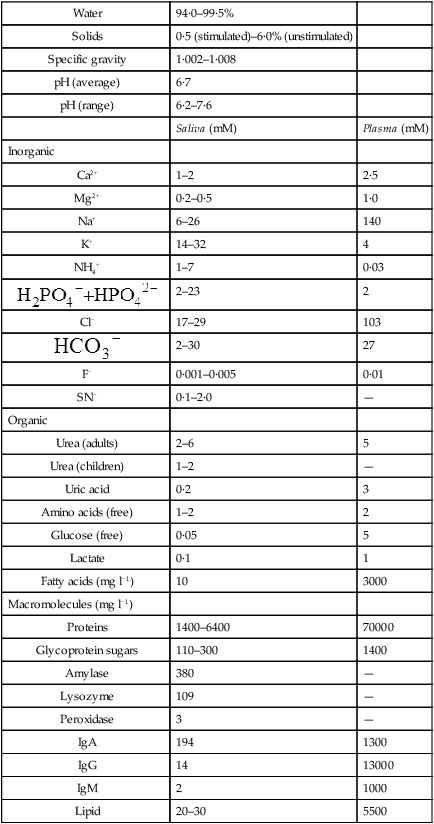The oral environment
Publisher Summary
This chapter discusses the oral environment. The oral cavity shows many of the biological characteristics of the gut as a whole. However, because of its exposed position at the beginning of the alimentary canal, its intrinsic biological properties are continually modified by environmental factors, particularly by contamination with microorganisms and by the intake of food. The bacteria that inhabit the mouth constitute a community of many different species, and a study of their interactions with the tissues of the oral cavity is necessary for an understanding of oral biology in health and disease. Organisms and their surroundings together constitute an ecosystem, and each ecosystem has physical, chemical, and biological properties that determine the composition of the community and dictate which organisms dominate the system and which will fail to survive. In the mouth, those populations for which it has favorable nutritional and physiological characteristics survive and unsuited species fail to become established, so that the community is maintained in balance by the operation of natural selection. Each organism has a particular biological role or niche within the community so that species with identical biological properties compete for the same niche; a mixed community becomes stable only when each organism has a different role to play thus avoiding competition. The mouth, together with the rest of the gut, constitutes a natural open system, and the oral cavity is regarded as a fermentation chamber providing a suitable environment for the continuous culture of microbial populations.

Saliva
The functions of saliva
Saliva has many functions the most important of which are as follows.
Protective
The properties of saliva which make it a good lubricant also help to protect the soft tissue surfaces from physical damage which might otherwise be caused by hard textured foods or excessive temperatures. Similarly, buffers present in saliva help to protect both hard and soft tissues from chemical damage resulting from bacterial acid production. Protection against the damaging effects of bacteria may also be provided by such specific components as immunoglobulins and lysozyme (page 409), which break down the coat polysaccharides of certain types of bacteria.
Digestive
Lubrication with saliva helps to soften the food and aids the formation and swallowing of a food bolus. The rate of removal of substances from the mouth depends on factors such as the rate of saliva flow, the adhesive properties of the food and the activity of salivary enzymes, notably amylase. This enzyme initiates the digestion of starch (page 224) and the breakdown and consequent removal of residual material commonly found around the teeth.
Miscellaneous
By lubricating the lips and tongue saliva facilitates speech and, since it acts as a solvent, it also aids gustation. Saliva may perhaps be considered to play a role in excretion since heavy metals such as mercury and lead are secreted into it; this does not, however, provide a final solution to the problem of their disposal since they are subsequently swallowed and may be reabsorbed. Lastly, to the great convenience of the dentist, the rheological* properties of saliva help to retain dentures in position although this can hardly be part of Nature’s grand design!
The composition of saliva
Saliva, for experimental work, can be collected with special cannulae directly from the ducts of the glands. This material is pure and sterile and truly representative of the secretion of the gland in question. However, mixed saliva, which is usually collected from the mouth during paraffin wax stimulation, is of very variable composition. In addition to fractions from each gland, it contains food debris, plaque, bacteria, degraded mammalian cells and possibly some gingival sulcus fluid. In spite of its heterogeneity and variability, the composition of mixed saliva is of great importance since it is this fluid which gives rise to the acquired enamel integuments (page 490). Some idea of the composition of a normal average sample of mixed saliva can be obtained from Table 33.1.
Table 33.1
The average composition of mixed human saliva and normal values for plasma
| Water | 94·0–99·5% | |
| Solids | 0·5 (stimulated)–6·0% (unstimulated) | |
| Specific gravity | 1·002–1·008 | |
| pH (average) | 6·7 | |
| pH (range) | 6·2–7·6 | |
| Saliva (mM) | Plasma (mM) | |
| Inorganic | ||
| Ca2+ | 1–2 | 2·5 |
| Mg2+ | 0·2–0·5 | 1·0 |
| Na+ | 6–26 | 140 |
| K+ | 14–32 | 4 |
| NH4+ | 1–7 | 0·03 |
 |
2–23 | 2 |
| Cl− | 17–29 | 103 |
 |
2–30 | 27 |
| F− | 0·001–0·005 | 0·01 |
| SN− | 0·1–2·0 | — |
| Organic | ||
| Urea (adults) | 2–6 | 5 |
| Urea (children) | 1–2 | — |
| Uric acid | 0·2 | 3 |
| Amino acids (free) | 1–2 | 2 |
| Glucose (free) | 0·05 | 5 |
| Lactate | 0·1 | 1 |
| Fatty acids (mg l−1) | 10 | 3000 |
| Macromolecules (mg l−1) | ||
| Proteins | 1400–6400 | 70000 |
| Glycoprotein sugars | 110–300 | 1400 |
| Amylase | 380 | — |
| Lysozyme | 109 | — |
| Peroxidase | 3 | — |
| IgA | 194 | 1300 |
| IgG | 14 | 13000 |
| IgM | 2 | 1000 |
| Lipid | 20–30 | 5500 |

Stay updated, free dental videos. Join our Telegram channel

VIDEdental - Online dental courses


